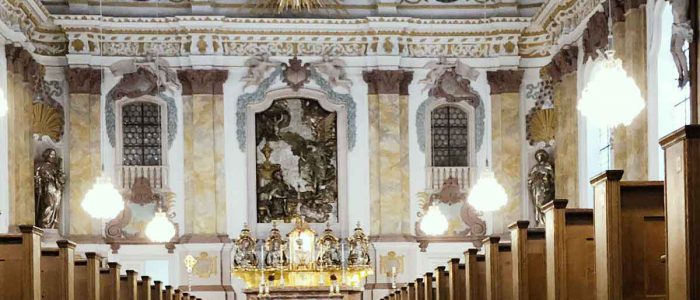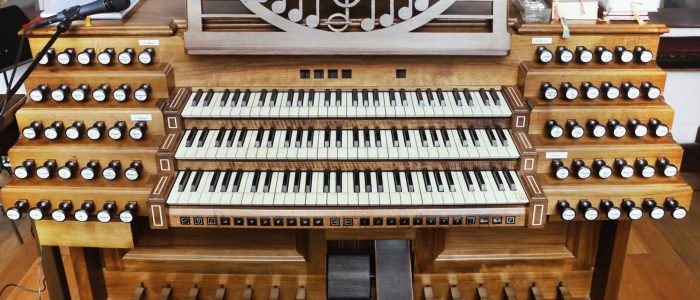München, Bürgersaalkirche, III/50 – Opus 290

Vollendete Klangästhetik in der Münchner Fußgängerzone...
Bürgersaalkirche in München, Orgelneubau 1994
In Anlehnung an einen Stich aus dem 18. Jahrhundert sind zwei große Gehäusekästen (12‘) vor die zwischen den Fenstern liegenden Wandflächen positioniert. Die vorhandene Aussparung in der Brüstung gibt Platz für ein kleines Brüstungspositiv (6‘). Durch die Aufgliederung der drei Gehäusefronten in je fünf Achsen wird eine schlanke Wirkung erzielt, diese nimmt den großen Prospektflächen die massive Wucht. Mit der Einbindung des Brüstungspositives in die vorhandene Profilierung und den fließenden Übergängen der Deckenstukkaturen in die Orgelornamentik, sowie mit einer Übernahme der Farbgebung der Raumschale für die Gehäusekästen samt Lisenen bis in das Schnitzwerk hinein wurde eine harmonische Integration des Orgelwerkes erreicht.
In accordance with a print from the 18th century 2 large cases (12’) were positioned in the wall area between the windows. Within the recess found in the balustrade there was just enough room for a small organ (6’). Due to the division of the 3 case fronts in each of the 5 axis a reducing effect was created that removes the massiveness of the organ. In connection with the balustrade organ a flowing connection is achieved between the ceiling decorations and in the ornaments on the organ. Also the same color scheme is used on the case and the trimming which matches the church interior. This provides for harmonic color integration.
Foto: Wolf-Christian v. d. Mülbe, Dachau.

DISPOSITION
I. Manual – Hauptwerk C – a‘‘‘
1. Praestant 16‘
2. Principal 8‘
3. Tibia 8‘
4. Gamba 8‘
5. Octave 4‘
6. Spitzflöte 4‘
7. Vox angelica 4‘
8. Quint 2 2/3‘
9. Superoctave 2‘
10. Terz 1 3/5‘
11. Larigot 1 1/3‘
12. Cornetmixtur 3f. 2 2/3‘
13. Mixtur 5f. 1 1/3‘
14. Fagott 16‘
15. Trompete 8‘
Tremulant
II. Manual – Positiv C – a‘‘‘
16. Bordun 16‘
17. Geigenprincipal 8‘
18. Rohrflöte 8‘
19. Principal 4‘
20. Traversflöte 4‘
21. Quintflöte 2 2/3‘
22. Flautino 2‘
23. Terzflöte 1 3/5‘
24. Sifflöte 1‘
25. Cymbal 3f. 1‘
26. Klarinette 8‘
27. Vox humana 8‘
Tremulant
III. Manual – Schwellwerk C – a‘‘‘
28. Gamba 16‘
29. Soloflöte 8‘
30. Salicional 8‘
31. Vox coelestis 8‘
32. Viola 4‘
33. Querflöte 4‘
34. Nasat 2 2/3‘
35. Piccolo 2‘
36. Violine 2‘
37. Terz 1 3/5‘
38. Harmonia aeth. 3f. 2‘
39. Oboe 8‘
40. Clarine 4‘
Tremulant
Pedal C – g‘
41. Principalbaß 16‘
42. Violonbaß 16‘
43. Subbaß 16‘
44. Quintbaß 10 2/3‘
45. Octavbaß 8‘
46. Flötbaß 8‘
47. Superoctavbaß 4‘
48. Hintersatz 3f. 2 2/3‘
49. Posaune 16‘
50. Zinke 8‘
Normalkoppeln
Mechanische Spieltraktur
elektrische Registertraktur
Crescendo-Walze
Elektronischer Setzer mit Sequenzern
Glockenspiel c°-a‘‘‘ auf I. oder II.
Cymbelstern, Vogelsang

